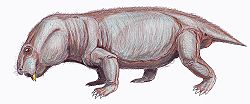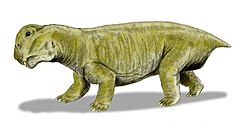| Pylaecephalidae Temporal range: Permian | |
|---|---|
 | |
| Fossil of Diictodon | |
| Scientific classification | |
| Kingdom: | Animalia |
| Phylum: | Chordata |
| Clade: | Synapsida |
| Clade: | Therapsida |
| Clade: | † Anomodontia |
| Clade: | † Dicynodontia |
| Family: | † Pylaecephalidae van Hoepen, 1934 |
| Type genus | |
| † Pylaecephalus Van Hoepen, 1934 | |
| Genera | |
| |
| Synonyms | |
| |
Pylaecephalidae is a family of dicynodont therapsids that includes Diictodon , Robertia , and Prosictodon from the Permian of South Africa. Pylaecephalids were small burrowing dicynodonts with long tusks. The family was first named in 1934 and was redefined in 2009. [1] Diictodontidae and Robertiidae are considered junior synonyms of Pylaecephalidae; [2] although Pylaecephalus itself is considered a junior synonym of Diictodon, [3] the name Pylaecephalidae predates these names and therefore takes priority. [1]





